Supporting Inclusion in Early Childhood Education
VerifiedAdded on 2023/04/08
|11
|2955
|228
AI Summary
This article discusses the role and importance of supporting inclusion in early childhood education. It explores strength-based strategies for inclusion and the benefits of inclusive learning. The article also highlights the team approach to supporting inclusion.
Contribute Materials
Your contribution can guide someone’s learning journey. Share your
documents today.
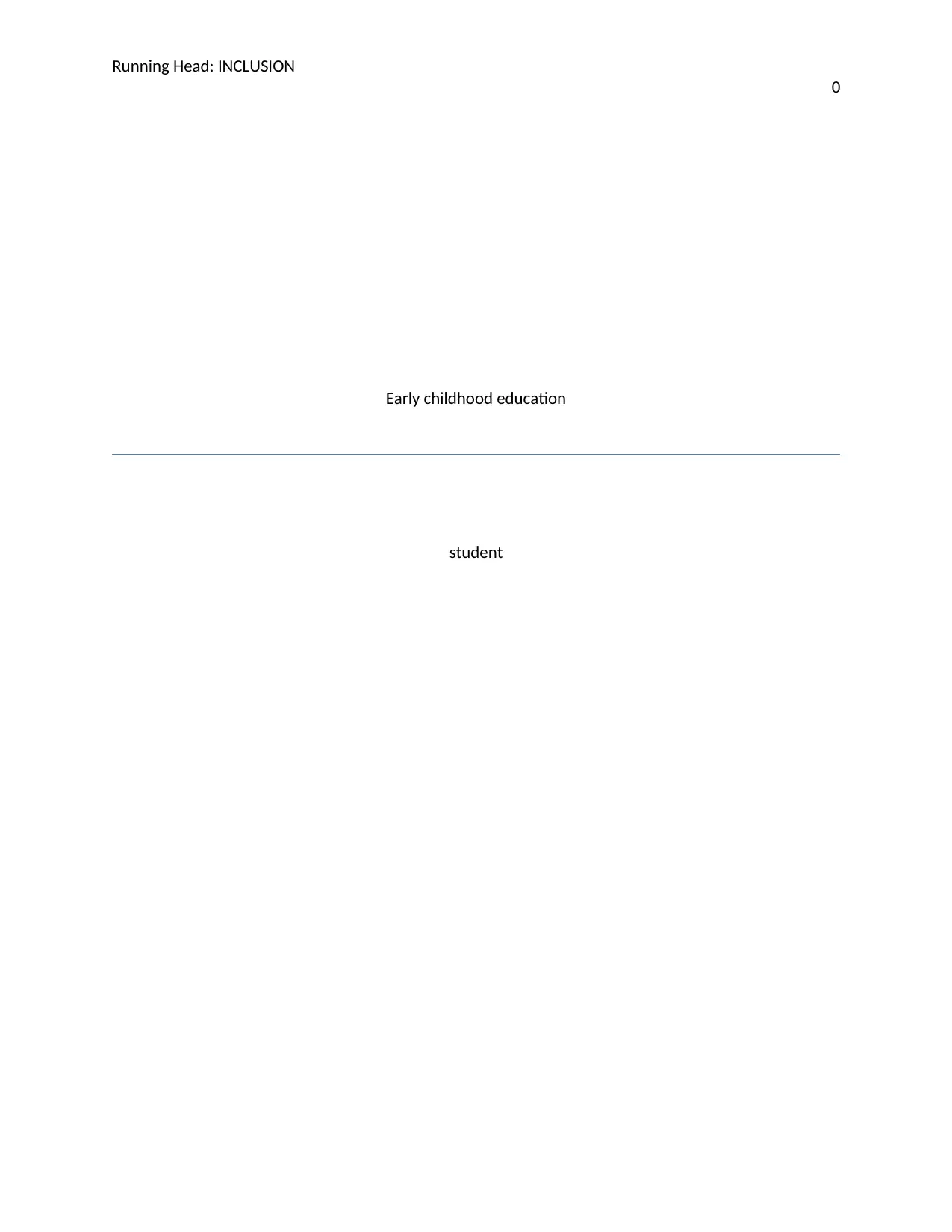
Running Head: INCLUSION
0
Early childhood education
student
0
Early childhood education
student
Secure Best Marks with AI Grader
Need help grading? Try our AI Grader for instant feedback on your assignments.
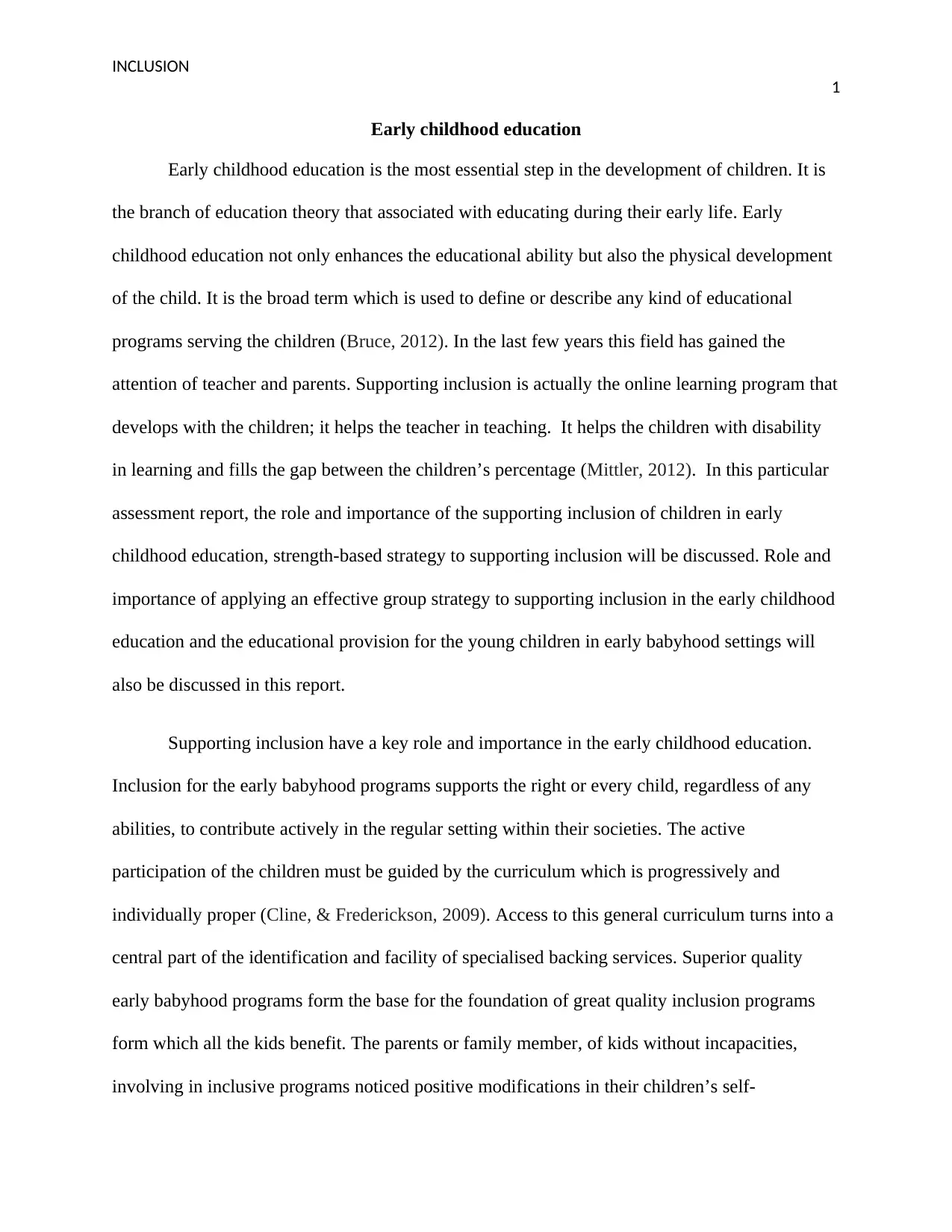
INCLUSION
1
Early childhood education
Early childhood education is the most essential step in the development of children. It is
the branch of education theory that associated with educating during their early life. Early
childhood education not only enhances the educational ability but also the physical development
of the child. It is the broad term which is used to define or describe any kind of educational
programs serving the children (Bruce, 2012). In the last few years this field has gained the
attention of teacher and parents. Supporting inclusion is actually the online learning program that
develops with the children; it helps the teacher in teaching. It helps the children with disability
in learning and fills the gap between the children’s percentage (Mittler, 2012). In this particular
assessment report, the role and importance of the supporting inclusion of children in early
childhood education, strength-based strategy to supporting inclusion will be discussed. Role and
importance of applying an effective group strategy to supporting inclusion in the early childhood
education and the educational provision for the young children in early babyhood settings will
also be discussed in this report.
Supporting inclusion have a key role and importance in the early childhood education.
Inclusion for the early babyhood programs supports the right or every child, regardless of any
abilities, to contribute actively in the regular setting within their societies. The active
participation of the children must be guided by the curriculum which is progressively and
individually proper (Cline, & Frederickson, 2009). Access to this general curriculum turns into a
central part of the identification and facility of specialised backing services. Superior quality
early babyhood programs form the base for the foundation of great quality inclusion programs
form which all the kids benefit. The parents or family member, of kids without incapacities,
involving in inclusive programs noticed positive modifications in their children’s self-
1
Early childhood education
Early childhood education is the most essential step in the development of children. It is
the branch of education theory that associated with educating during their early life. Early
childhood education not only enhances the educational ability but also the physical development
of the child. It is the broad term which is used to define or describe any kind of educational
programs serving the children (Bruce, 2012). In the last few years this field has gained the
attention of teacher and parents. Supporting inclusion is actually the online learning program that
develops with the children; it helps the teacher in teaching. It helps the children with disability
in learning and fills the gap between the children’s percentage (Mittler, 2012). In this particular
assessment report, the role and importance of the supporting inclusion of children in early
childhood education, strength-based strategy to supporting inclusion will be discussed. Role and
importance of applying an effective group strategy to supporting inclusion in the early childhood
education and the educational provision for the young children in early babyhood settings will
also be discussed in this report.
Supporting inclusion have a key role and importance in the early childhood education.
Inclusion for the early babyhood programs supports the right or every child, regardless of any
abilities, to contribute actively in the regular setting within their societies. The active
participation of the children must be guided by the curriculum which is progressively and
individually proper (Cline, & Frederickson, 2009). Access to this general curriculum turns into a
central part of the identification and facility of specialised backing services. Superior quality
early babyhood programs form the base for the foundation of great quality inclusion programs
form which all the kids benefit. The parents or family member, of kids without incapacities,
involving in inclusive programs noticed positive modifications in their children’s self-
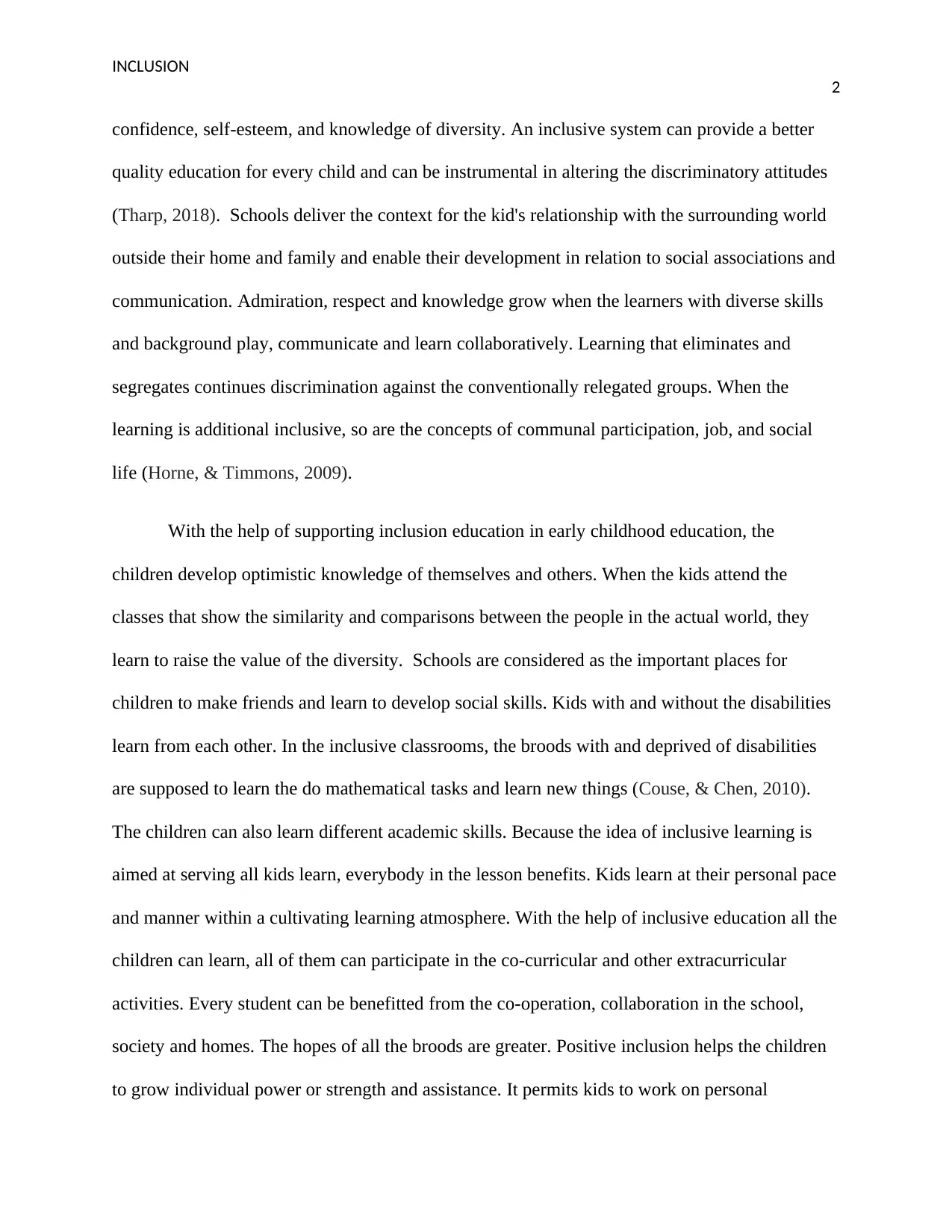
INCLUSION
2
confidence, self-esteem, and knowledge of diversity. An inclusive system can provide a better
quality education for every child and can be instrumental in altering the discriminatory attitudes
(Tharp, 2018). Schools deliver the context for the kid's relationship with the surrounding world
outside their home and family and enable their development in relation to social associations and
communication. Admiration, respect and knowledge grow when the learners with diverse skills
and background play, communicate and learn collaboratively. Learning that eliminates and
segregates continues discrimination against the conventionally relegated groups. When the
learning is additional inclusive, so are the concepts of communal participation, job, and social
life (Horne, & Timmons, 2009).
With the help of supporting inclusion education in early childhood education, the
children develop optimistic knowledge of themselves and others. When the kids attend the
classes that show the similarity and comparisons between the people in the actual world, they
learn to raise the value of the diversity. Schools are considered as the important places for
children to make friends and learn to develop social skills. Kids with and without the disabilities
learn from each other. In the inclusive classrooms, the broods with and deprived of disabilities
are supposed to learn the do mathematical tasks and learn new things (Couse, & Chen, 2010).
The children can also learn different academic skills. Because the idea of inclusive learning is
aimed at serving all kids learn, everybody in the lesson benefits. Kids learn at their personal pace
and manner within a cultivating learning atmosphere. With the help of inclusive education all the
children can learn, all of them can participate in the co-curricular and other extracurricular
activities. Every student can be benefitted from the co-operation, collaboration in the school,
society and homes. The hopes of all the broods are greater. Positive inclusion helps the children
to grow individual power or strength and assistance. It permits kids to work on personal
2
confidence, self-esteem, and knowledge of diversity. An inclusive system can provide a better
quality education for every child and can be instrumental in altering the discriminatory attitudes
(Tharp, 2018). Schools deliver the context for the kid's relationship with the surrounding world
outside their home and family and enable their development in relation to social associations and
communication. Admiration, respect and knowledge grow when the learners with diverse skills
and background play, communicate and learn collaboratively. Learning that eliminates and
segregates continues discrimination against the conventionally relegated groups. When the
learning is additional inclusive, so are the concepts of communal participation, job, and social
life (Horne, & Timmons, 2009).
With the help of supporting inclusion education in early childhood education, the
children develop optimistic knowledge of themselves and others. When the kids attend the
classes that show the similarity and comparisons between the people in the actual world, they
learn to raise the value of the diversity. Schools are considered as the important places for
children to make friends and learn to develop social skills. Kids with and without the disabilities
learn from each other. In the inclusive classrooms, the broods with and deprived of disabilities
are supposed to learn the do mathematical tasks and learn new things (Couse, & Chen, 2010).
The children can also learn different academic skills. Because the idea of inclusive learning is
aimed at serving all kids learn, everybody in the lesson benefits. Kids learn at their personal pace
and manner within a cultivating learning atmosphere. With the help of inclusive education all the
children can learn, all of them can participate in the co-curricular and other extracurricular
activities. Every student can be benefitted from the co-operation, collaboration in the school,
society and homes. The hopes of all the broods are greater. Positive inclusion helps the children
to grow individual power or strength and assistance. It permits kids to work on personal
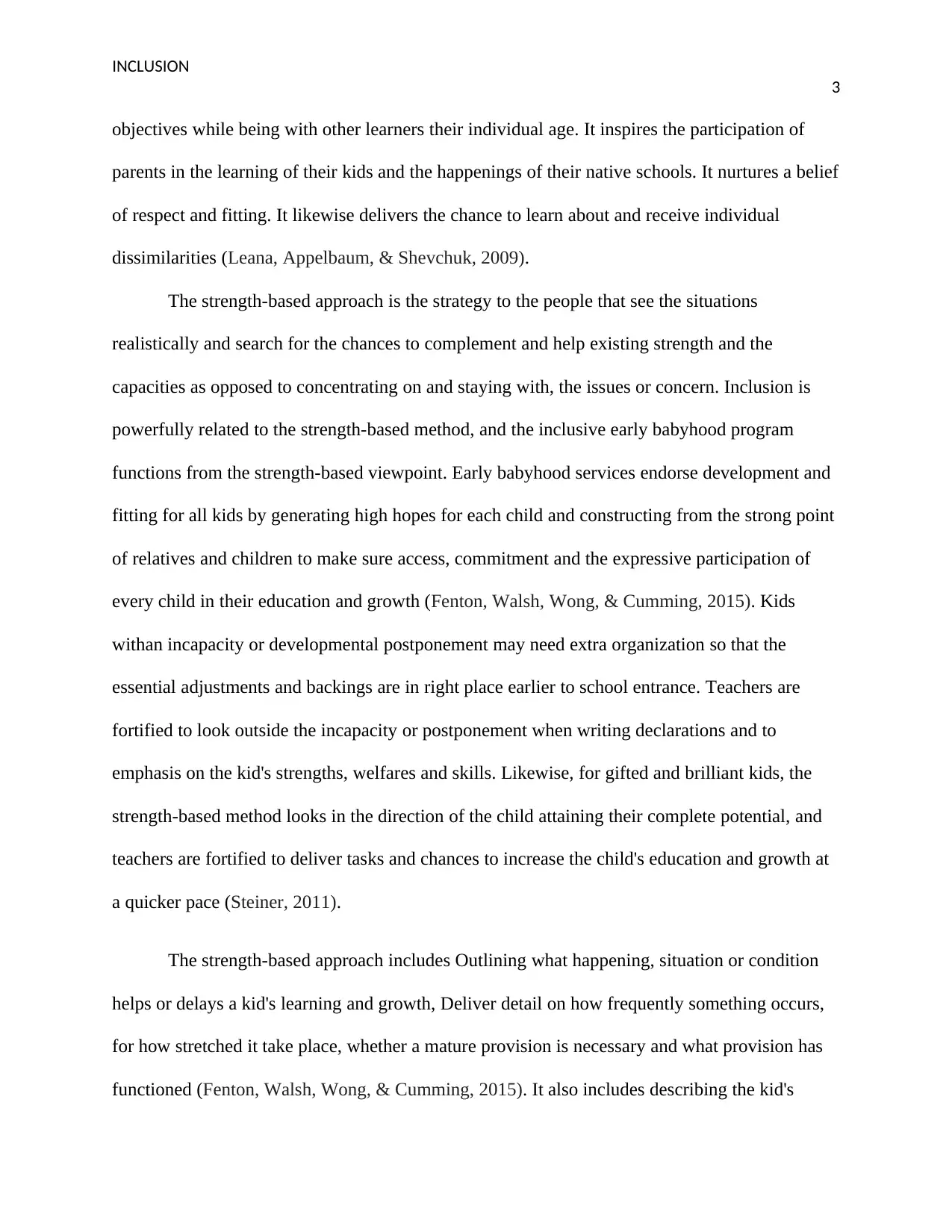
INCLUSION
3
objectives while being with other learners their individual age. It inspires the participation of
parents in the learning of their kids and the happenings of their native schools. It nurtures a belief
of respect and fitting. It likewise delivers the chance to learn about and receive individual
dissimilarities (Leana, Appelbaum, & Shevchuk, 2009).
The strength-based approach is the strategy to the people that see the situations
realistically and search for the chances to complement and help existing strength and the
capacities as opposed to concentrating on and staying with, the issues or concern. Inclusion is
powerfully related to the strength-based method, and the inclusive early babyhood program
functions from the strength-based viewpoint. Early babyhood services endorse development and
fitting for all kids by generating high hopes for each child and constructing from the strong point
of relatives and children to make sure access, commitment and the expressive participation of
every child in their education and growth (Fenton, Walsh, Wong, & Cumming, 2015). Kids
withan incapacity or developmental postponement may need extra organization so that the
essential adjustments and backings are in right place earlier to school entrance. Teachers are
fortified to look outside the incapacity or postponement when writing declarations and to
emphasis on the kid's strengths, welfares and skills. Likewise, for gifted and brilliant kids, the
strength-based method looks in the direction of the child attaining their complete potential, and
teachers are fortified to deliver tasks and chances to increase the child's education and growth at
a quicker pace (Steiner, 2011).
The strength-based approach includes Outlining what happening, situation or condition
helps or delays a kid's learning and growth, Deliver detail on how frequently something occurs,
for how stretched it take place, whether a mature provision is necessary and what provision has
functioned (Fenton, Walsh, Wong, & Cumming, 2015). It also includes describing the kid's
3
objectives while being with other learners their individual age. It inspires the participation of
parents in the learning of their kids and the happenings of their native schools. It nurtures a belief
of respect and fitting. It likewise delivers the chance to learn about and receive individual
dissimilarities (Leana, Appelbaum, & Shevchuk, 2009).
The strength-based approach is the strategy to the people that see the situations
realistically and search for the chances to complement and help existing strength and the
capacities as opposed to concentrating on and staying with, the issues or concern. Inclusion is
powerfully related to the strength-based method, and the inclusive early babyhood program
functions from the strength-based viewpoint. Early babyhood services endorse development and
fitting for all kids by generating high hopes for each child and constructing from the strong point
of relatives and children to make sure access, commitment and the expressive participation of
every child in their education and growth (Fenton, Walsh, Wong, & Cumming, 2015). Kids
withan incapacity or developmental postponement may need extra organization so that the
essential adjustments and backings are in right place earlier to school entrance. Teachers are
fortified to look outside the incapacity or postponement when writing declarations and to
emphasis on the kid's strengths, welfares and skills. Likewise, for gifted and brilliant kids, the
strength-based method looks in the direction of the child attaining their complete potential, and
teachers are fortified to deliver tasks and chances to increase the child's education and growth at
a quicker pace (Steiner, 2011).
The strength-based approach includes Outlining what happening, situation or condition
helps or delays a kid's learning and growth, Deliver detail on how frequently something occurs,
for how stretched it take place, whether a mature provision is necessary and what provision has
functioned (Fenton, Walsh, Wong, & Cumming, 2015). It also includes describing the kid's
Secure Best Marks with AI Grader
Need help grading? Try our AI Grader for instant feedback on your assignments.
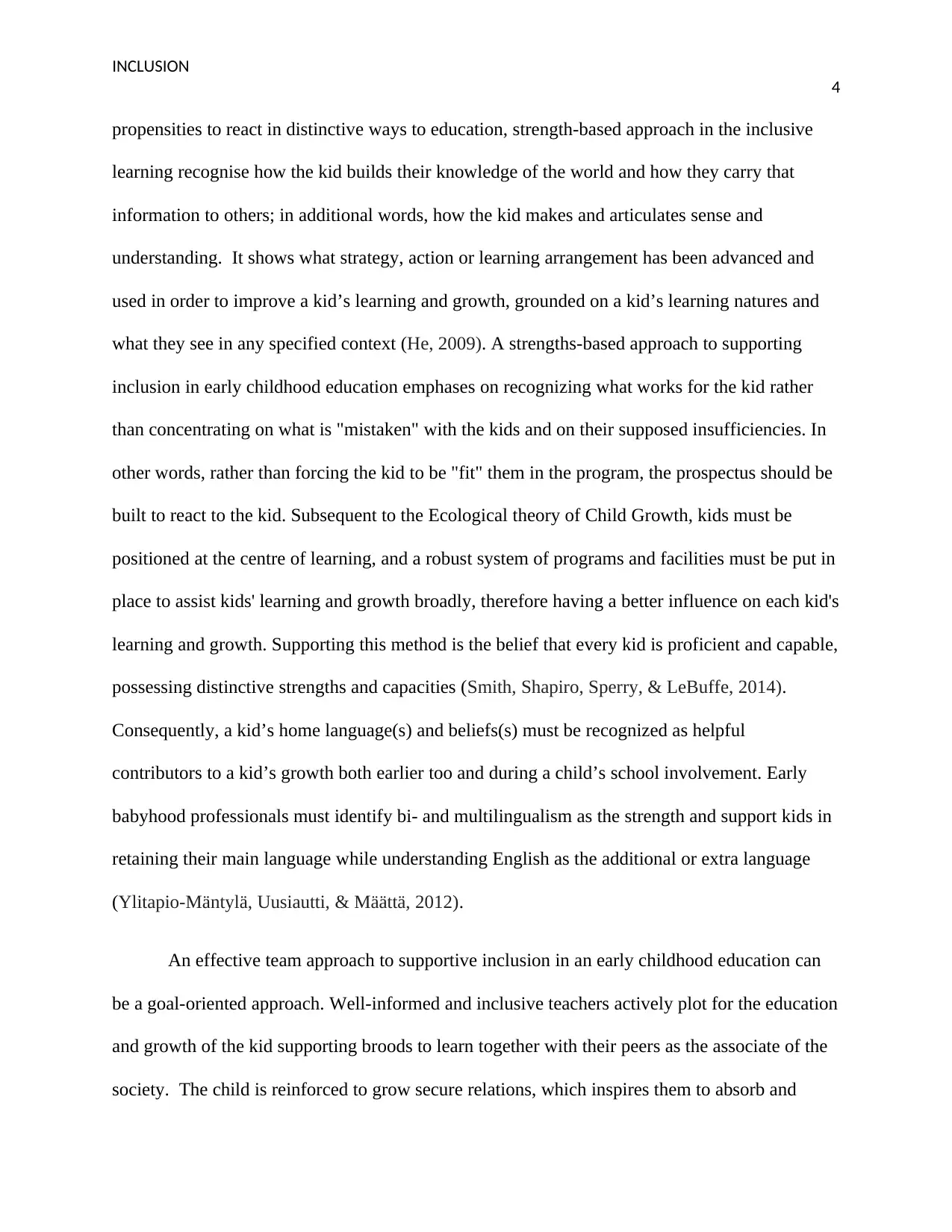
INCLUSION
4
propensities to react in distinctive ways to education, strength-based approach in the inclusive
learning recognise how the kid builds their knowledge of the world and how they carry that
information to others; in additional words, how the kid makes and articulates sense and
understanding. It shows what strategy, action or learning arrangement has been advanced and
used in order to improve a kid’s learning and growth, grounded on a kid’s learning natures and
what they see in any specified context (He, 2009). A strengths-based approach to supporting
inclusion in early childhood education emphases on recognizing what works for the kid rather
than concentrating on what is "mistaken" with the kids and on their supposed insufficiencies. In
other words, rather than forcing the kid to be "fit" them in the program, the prospectus should be
built to react to the kid. Subsequent to the Ecological theory of Child Growth, kids must be
positioned at the centre of learning, and a robust system of programs and facilities must be put in
place to assist kids' learning and growth broadly, therefore having a better influence on each kid's
learning and growth. Supporting this method is the belief that every kid is proficient and capable,
possessing distinctive strengths and capacities (Smith, Shapiro, Sperry, & LeBuffe, 2014).
Consequently, a kid’s home language(s) and beliefs(s) must be recognized as helpful
contributors to a kid’s growth both earlier too and during a child’s school involvement. Early
babyhood professionals must identify bi- and multilingualism as the strength and support kids in
retaining their main language while understanding English as the additional or extra language
(Ylitapio-Mäntylä, Uusiautti, & Määttä, 2012).
An effective team approach to supportive inclusion in an early childhood education can
be a goal-oriented approach. Well-informed and inclusive teachers actively plot for the education
and growth of the kid supporting broods to learn together with their peers as the associate of the
society. The child is reinforced to grow secure relations, which inspires them to absorb and
4
propensities to react in distinctive ways to education, strength-based approach in the inclusive
learning recognise how the kid builds their knowledge of the world and how they carry that
information to others; in additional words, how the kid makes and articulates sense and
understanding. It shows what strategy, action or learning arrangement has been advanced and
used in order to improve a kid’s learning and growth, grounded on a kid’s learning natures and
what they see in any specified context (He, 2009). A strengths-based approach to supporting
inclusion in early childhood education emphases on recognizing what works for the kid rather
than concentrating on what is "mistaken" with the kids and on their supposed insufficiencies. In
other words, rather than forcing the kid to be "fit" them in the program, the prospectus should be
built to react to the kid. Subsequent to the Ecological theory of Child Growth, kids must be
positioned at the centre of learning, and a robust system of programs and facilities must be put in
place to assist kids' learning and growth broadly, therefore having a better influence on each kid's
learning and growth. Supporting this method is the belief that every kid is proficient and capable,
possessing distinctive strengths and capacities (Smith, Shapiro, Sperry, & LeBuffe, 2014).
Consequently, a kid’s home language(s) and beliefs(s) must be recognized as helpful
contributors to a kid’s growth both earlier too and during a child’s school involvement. Early
babyhood professionals must identify bi- and multilingualism as the strength and support kids in
retaining their main language while understanding English as the additional or extra language
(Ylitapio-Mäntylä, Uusiautti, & Määttä, 2012).
An effective team approach to supportive inclusion in an early childhood education can
be a goal-oriented approach. Well-informed and inclusive teachers actively plot for the education
and growth of the kid supporting broods to learn together with their peers as the associate of the
society. The child is reinforced to grow secure relations, which inspires them to absorb and
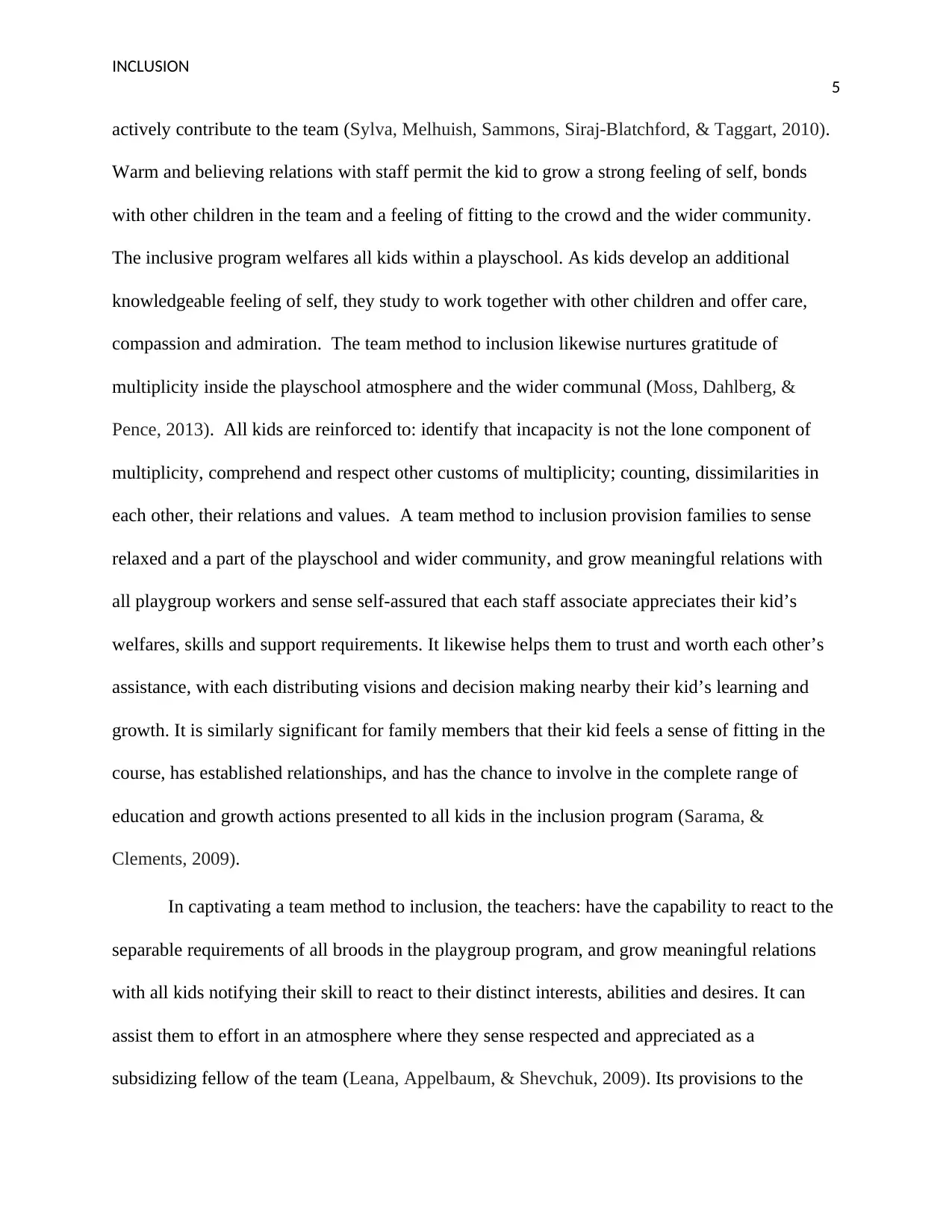
INCLUSION
5
actively contribute to the team (Sylva, Melhuish, Sammons, Siraj-Blatchford, & Taggart, 2010).
Warm and believing relations with staff permit the kid to grow a strong feeling of self, bonds
with other children in the team and a feeling of fitting to the crowd and the wider community.
The inclusive program welfares all kids within a playschool. As kids develop an additional
knowledgeable feeling of self, they study to work together with other children and offer care,
compassion and admiration. The team method to inclusion likewise nurtures gratitude of
multiplicity inside the playschool atmosphere and the wider communal (Moss, Dahlberg, &
Pence, 2013). All kids are reinforced to: identify that incapacity is not the lone component of
multiplicity, comprehend and respect other customs of multiplicity; counting, dissimilarities in
each other, their relations and values. A team method to inclusion provision families to sense
relaxed and a part of the playschool and wider community, and grow meaningful relations with
all playgroup workers and sense self-assured that each staff associate appreciates their kid’s
welfares, skills and support requirements. It likewise helps them to trust and worth each other’s
assistance, with each distributing visions and decision making nearby their kid’s learning and
growth. It is similarly significant for family members that their kid feels a sense of fitting in the
course, has established relationships, and has the chance to involve in the complete range of
education and growth actions presented to all kids in the inclusion program (Sarama, &
Clements, 2009).
In captivating a team method to inclusion, the teachers: have the capability to react to the
separable requirements of all broods in the playgroup program, and grow meaningful relations
with all kids notifying their skill to react to their distinct interests, abilities and desires. It can
assist them to effort in an atmosphere where they sense respected and appreciated as a
subsidizing fellow of the team (Leana, Appelbaum, & Shevchuk, 2009). Its provisions to the
5
actively contribute to the team (Sylva, Melhuish, Sammons, Siraj-Blatchford, & Taggart, 2010).
Warm and believing relations with staff permit the kid to grow a strong feeling of self, bonds
with other children in the team and a feeling of fitting to the crowd and the wider community.
The inclusive program welfares all kids within a playschool. As kids develop an additional
knowledgeable feeling of self, they study to work together with other children and offer care,
compassion and admiration. The team method to inclusion likewise nurtures gratitude of
multiplicity inside the playschool atmosphere and the wider communal (Moss, Dahlberg, &
Pence, 2013). All kids are reinforced to: identify that incapacity is not the lone component of
multiplicity, comprehend and respect other customs of multiplicity; counting, dissimilarities in
each other, their relations and values. A team method to inclusion provision families to sense
relaxed and a part of the playschool and wider community, and grow meaningful relations with
all playgroup workers and sense self-assured that each staff associate appreciates their kid’s
welfares, skills and support requirements. It likewise helps them to trust and worth each other’s
assistance, with each distributing visions and decision making nearby their kid’s learning and
growth. It is similarly significant for family members that their kid feels a sense of fitting in the
course, has established relationships, and has the chance to involve in the complete range of
education and growth actions presented to all kids in the inclusion program (Sarama, &
Clements, 2009).
In captivating a team method to inclusion, the teachers: have the capability to react to the
separable requirements of all broods in the playgroup program, and grow meaningful relations
with all kids notifying their skill to react to their distinct interests, abilities and desires. It can
assist them to effort in an atmosphere where they sense respected and appreciated as a
subsidizing fellow of the team (Leana, Appelbaum, & Shevchuk, 2009). Its provisions to the

INCLUSION
6
playschool’s organization team vigorously backings and endorse the playschool’s inclusive
method through attitude, rules and events (Odom, Buysse, & Soukakou, 2011). These strategies
provision the playschool team to endorse and appliance inclusive exercise in daily programs. In
the inclusive squad, the early childhood educator shows robust headship and flexibility in the
manner they provide the program (Britto, Lye, Proulx, Yousafzai, Matthews, Vaivada, &
MacMillan, 2017). They make sure that every staff associate comprehends their part and
accountabilities in providing the inclusive program. Worker shares the accountability of upkeep,
learning and growth of all kids; letting all broods to grow warm relations with all the workers
(McDevitt, & Ormrod, 2010).
The Society of Provision to Support Inclusive Learning addresses the query: how are
schemes of provision prearranged to encounter the requirements of learners recognized as
having incapacities. Inclusive learning is, however, an argumentative word that lacks a close-
fitting theoretical emphasis, which might subsidize to its delusion and disorganized practice.
Global human rights contracts, agreements, and lawmaking deliver meanings of inclusion that
emphasis on fairness, access, chance and rights (Nores, & Barnett, 2010). These topographies are
understood into exercise with meanings that conceptualise inclusion learning into two
comprehensive means; first based on important structures and other is the elimination of that
which eliminates and marginalises. In the deficiency of a united meaning of what inclusion is,
efforts to measure or relate such a multifaceted impartiality issue are puzzling (Sarama, &
Clements, 2009). All Australian authorities have inclusive rules and firmly recognized structures
for assisting learners with infirmity, with thorough and fairly complex events for classifying
eligibility of learners and the provision of support obligatory. In Victoria federations that are
dedicated to transporting an inclusive teaching system that makes sure all learners have
6
playschool’s organization team vigorously backings and endorse the playschool’s inclusive
method through attitude, rules and events (Odom, Buysse, & Soukakou, 2011). These strategies
provision the playschool team to endorse and appliance inclusive exercise in daily programs. In
the inclusive squad, the early childhood educator shows robust headship and flexibility in the
manner they provide the program (Britto, Lye, Proulx, Yousafzai, Matthews, Vaivada, &
MacMillan, 2017). They make sure that every staff associate comprehends their part and
accountabilities in providing the inclusive program. Worker shares the accountability of upkeep,
learning and growth of all kids; letting all broods to grow warm relations with all the workers
(McDevitt, & Ormrod, 2010).
The Society of Provision to Support Inclusive Learning addresses the query: how are
schemes of provision prearranged to encounter the requirements of learners recognized as
having incapacities. Inclusive learning is, however, an argumentative word that lacks a close-
fitting theoretical emphasis, which might subsidize to its delusion and disorganized practice.
Global human rights contracts, agreements, and lawmaking deliver meanings of inclusion that
emphasis on fairness, access, chance and rights (Nores, & Barnett, 2010). These topographies are
understood into exercise with meanings that conceptualise inclusion learning into two
comprehensive means; first based on important structures and other is the elimination of that
which eliminates and marginalises. In the deficiency of a united meaning of what inclusion is,
efforts to measure or relate such a multifaceted impartiality issue are puzzling (Sarama, &
Clements, 2009). All Australian authorities have inclusive rules and firmly recognized structures
for assisting learners with infirmity, with thorough and fairly complex events for classifying
eligibility of learners and the provision of support obligatory. In Victoria federations that are
dedicated to transporting an inclusive teaching system that makes sure all learners have
Paraphrase This Document
Need a fresh take? Get an instant paraphrase of this document with our AI Paraphraser
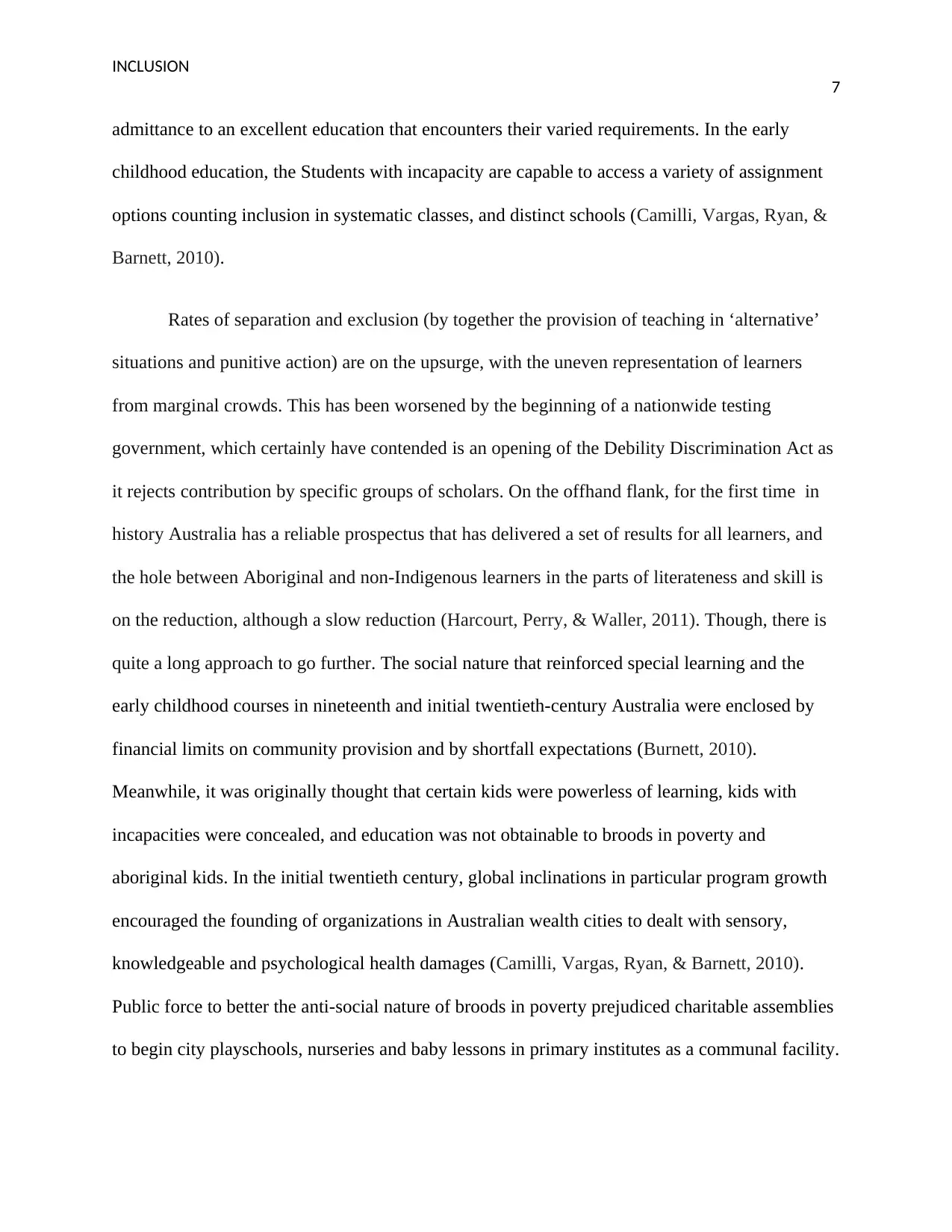
INCLUSION
7
admittance to an excellent education that encounters their varied requirements. In the early
childhood education, the Students with incapacity are capable to access a variety of assignment
options counting inclusion in systematic classes, and distinct schools (Camilli, Vargas, Ryan, &
Barnett, 2010).
Rates of separation and exclusion (by together the provision of teaching in ‘alternative’
situations and punitive action) are on the upsurge, with the uneven representation of learners
from marginal crowds. This has been worsened by the beginning of a nationwide testing
government, which certainly have contended is an opening of the Debility Discrimination Act as
it rejects contribution by specific groups of scholars. On the offhand flank, for the first time in
history Australia has a reliable prospectus that has delivered a set of results for all learners, and
the hole between Aboriginal and non-Indigenous learners in the parts of literateness and skill is
on the reduction, although a slow reduction (Harcourt, Perry, & Waller, 2011). Though, there is
quite a long approach to go further. The social nature that reinforced special learning and the
early childhood courses in nineteenth and initial twentieth-century Australia were enclosed by
financial limits on community provision and by shortfall expectations (Burnett, 2010).
Meanwhile, it was originally thought that certain kids were powerless of learning, kids with
incapacities were concealed, and education was not obtainable to broods in poverty and
aboriginal kids. In the initial twentieth century, global inclinations in particular program growth
encouraged the founding of organizations in Australian wealth cities to dealt with sensory,
knowledgeable and psychological health damages (Camilli, Vargas, Ryan, & Barnett, 2010).
Public force to better the anti-social nature of broods in poverty prejudiced charitable assemblies
to begin city playschools, nurseries and baby lessons in primary institutes as a communal facility.
7
admittance to an excellent education that encounters their varied requirements. In the early
childhood education, the Students with incapacity are capable to access a variety of assignment
options counting inclusion in systematic classes, and distinct schools (Camilli, Vargas, Ryan, &
Barnett, 2010).
Rates of separation and exclusion (by together the provision of teaching in ‘alternative’
situations and punitive action) are on the upsurge, with the uneven representation of learners
from marginal crowds. This has been worsened by the beginning of a nationwide testing
government, which certainly have contended is an opening of the Debility Discrimination Act as
it rejects contribution by specific groups of scholars. On the offhand flank, for the first time in
history Australia has a reliable prospectus that has delivered a set of results for all learners, and
the hole between Aboriginal and non-Indigenous learners in the parts of literateness and skill is
on the reduction, although a slow reduction (Harcourt, Perry, & Waller, 2011). Though, there is
quite a long approach to go further. The social nature that reinforced special learning and the
early childhood courses in nineteenth and initial twentieth-century Australia were enclosed by
financial limits on community provision and by shortfall expectations (Burnett, 2010).
Meanwhile, it was originally thought that certain kids were powerless of learning, kids with
incapacities were concealed, and education was not obtainable to broods in poverty and
aboriginal kids. In the initial twentieth century, global inclinations in particular program growth
encouraged the founding of organizations in Australian wealth cities to dealt with sensory,
knowledgeable and psychological health damages (Camilli, Vargas, Ryan, & Barnett, 2010).
Public force to better the anti-social nature of broods in poverty prejudiced charitable assemblies
to begin city playschools, nurseries and baby lessons in primary institutes as a communal facility.
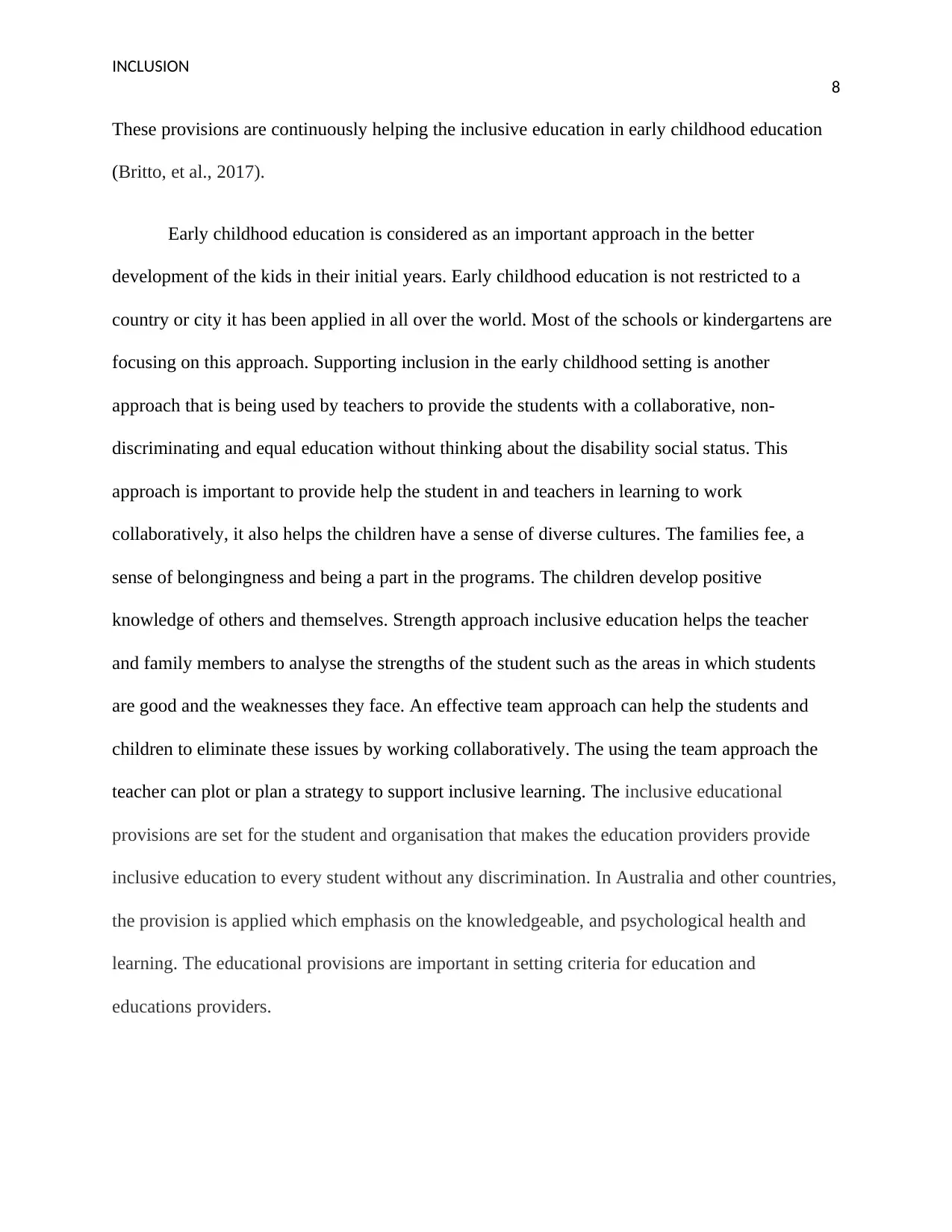
INCLUSION
8
These provisions are continuously helping the inclusive education in early childhood education
(Britto, et al., 2017).
Early childhood education is considered as an important approach in the better
development of the kids in their initial years. Early childhood education is not restricted to a
country or city it has been applied in all over the world. Most of the schools or kindergartens are
focusing on this approach. Supporting inclusion in the early childhood setting is another
approach that is being used by teachers to provide the students with a collaborative, non-
discriminating and equal education without thinking about the disability social status. This
approach is important to provide help the student in and teachers in learning to work
collaboratively, it also helps the children have a sense of diverse cultures. The families fee, a
sense of belongingness and being a part in the programs. The children develop positive
knowledge of others and themselves. Strength approach inclusive education helps the teacher
and family members to analyse the strengths of the student such as the areas in which students
are good and the weaknesses they face. An effective team approach can help the students and
children to eliminate these issues by working collaboratively. The using the team approach the
teacher can plot or plan a strategy to support inclusive learning. The inclusive educational
provisions are set for the student and organisation that makes the education providers provide
inclusive education to every student without any discrimination. In Australia and other countries,
the provision is applied which emphasis on the knowledgeable, and psychological health and
learning. The educational provisions are important in setting criteria for education and
educations providers.
8
These provisions are continuously helping the inclusive education in early childhood education
(Britto, et al., 2017).
Early childhood education is considered as an important approach in the better
development of the kids in their initial years. Early childhood education is not restricted to a
country or city it has been applied in all over the world. Most of the schools or kindergartens are
focusing on this approach. Supporting inclusion in the early childhood setting is another
approach that is being used by teachers to provide the students with a collaborative, non-
discriminating and equal education without thinking about the disability social status. This
approach is important to provide help the student in and teachers in learning to work
collaboratively, it also helps the children have a sense of diverse cultures. The families fee, a
sense of belongingness and being a part in the programs. The children develop positive
knowledge of others and themselves. Strength approach inclusive education helps the teacher
and family members to analyse the strengths of the student such as the areas in which students
are good and the weaknesses they face. An effective team approach can help the students and
children to eliminate these issues by working collaboratively. The using the team approach the
teacher can plot or plan a strategy to support inclusive learning. The inclusive educational
provisions are set for the student and organisation that makes the education providers provide
inclusive education to every student without any discrimination. In Australia and other countries,
the provision is applied which emphasis on the knowledgeable, and psychological health and
learning. The educational provisions are important in setting criteria for education and
educations providers.
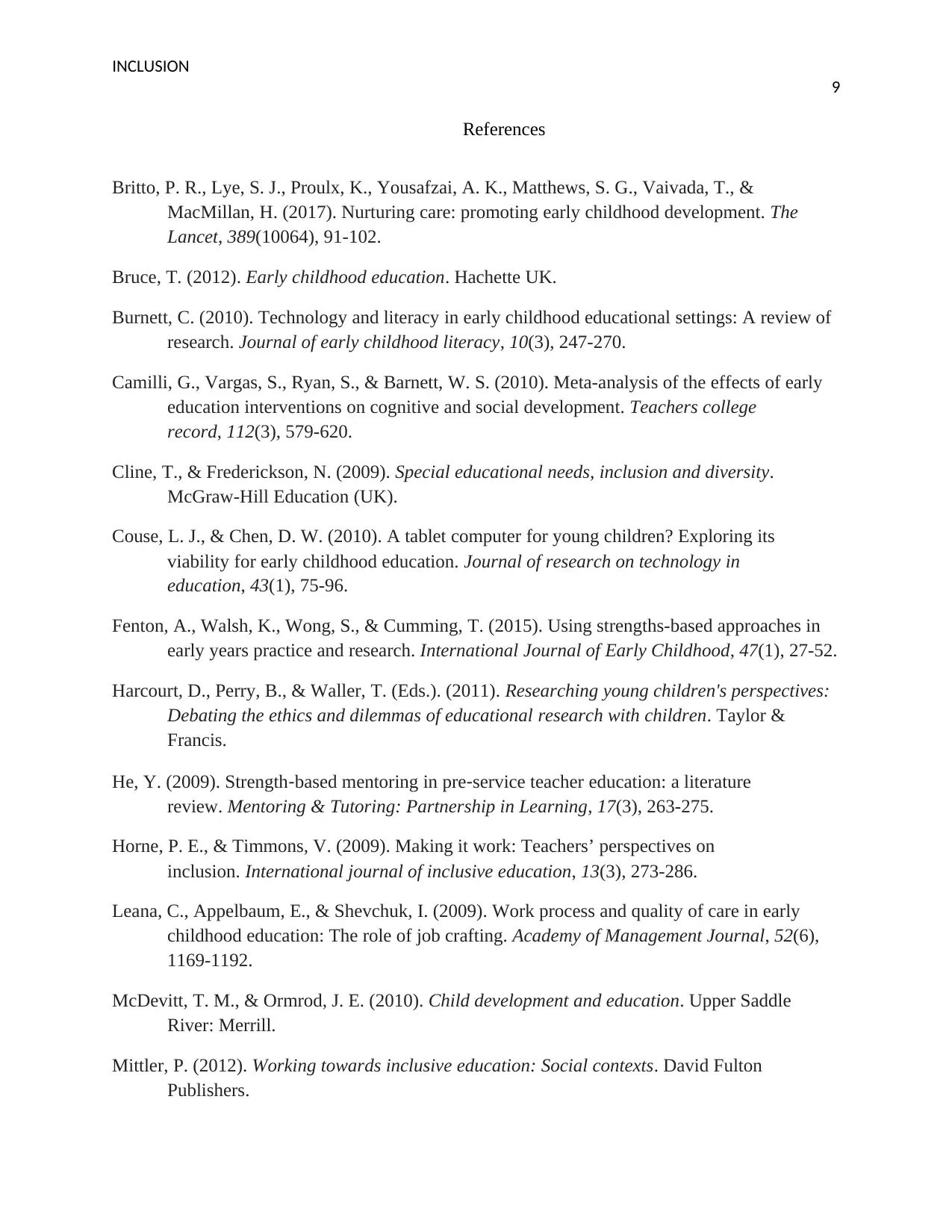
INCLUSION
9
References
Britto, P. R., Lye, S. J., Proulx, K., Yousafzai, A. K., Matthews, S. G., Vaivada, T., &
MacMillan, H. (2017). Nurturing care: promoting early childhood development. The
Lancet, 389(10064), 91-102.
Bruce, T. (2012). Early childhood education. Hachette UK.
Burnett, C. (2010). Technology and literacy in early childhood educational settings: A review of
research. Journal of early childhood literacy, 10(3), 247-270.
Camilli, G., Vargas, S., Ryan, S., & Barnett, W. S. (2010). Meta-analysis of the effects of early
education interventions on cognitive and social development. Teachers college
record, 112(3), 579-620.
Cline, T., & Frederickson, N. (2009). Special educational needs, inclusion and diversity.
McGraw-Hill Education (UK).
Couse, L. J., & Chen, D. W. (2010). A tablet computer for young children? Exploring its
viability for early childhood education. Journal of research on technology in
education, 43(1), 75-96.
Fenton, A., Walsh, K., Wong, S., & Cumming, T. (2015). Using strengths-based approaches in
early years practice and research. International Journal of Early Childhood, 47(1), 27-52.
Harcourt, D., Perry, B., & Waller, T. (Eds.). (2011). Researching young children's perspectives:
Debating the ethics and dilemmas of educational research with children. Taylor &
Francis.
He, Y. (2009). Strength‐based mentoring in pre‐service teacher education: a literature
review. Mentoring & Tutoring: Partnership in Learning, 17(3), 263-275.
Horne, P. E., & Timmons, V. (2009). Making it work: Teachers’ perspectives on
inclusion. International journal of inclusive education, 13(3), 273-286.
Leana, C., Appelbaum, E., & Shevchuk, I. (2009). Work process and quality of care in early
childhood education: The role of job crafting. Academy of Management Journal, 52(6),
1169-1192.
McDevitt, T. M., & Ormrod, J. E. (2010). Child development and education. Upper Saddle
River: Merrill.
Mittler, P. (2012). Working towards inclusive education: Social contexts. David Fulton
Publishers.
9
References
Britto, P. R., Lye, S. J., Proulx, K., Yousafzai, A. K., Matthews, S. G., Vaivada, T., &
MacMillan, H. (2017). Nurturing care: promoting early childhood development. The
Lancet, 389(10064), 91-102.
Bruce, T. (2012). Early childhood education. Hachette UK.
Burnett, C. (2010). Technology and literacy in early childhood educational settings: A review of
research. Journal of early childhood literacy, 10(3), 247-270.
Camilli, G., Vargas, S., Ryan, S., & Barnett, W. S. (2010). Meta-analysis of the effects of early
education interventions on cognitive and social development. Teachers college
record, 112(3), 579-620.
Cline, T., & Frederickson, N. (2009). Special educational needs, inclusion and diversity.
McGraw-Hill Education (UK).
Couse, L. J., & Chen, D. W. (2010). A tablet computer for young children? Exploring its
viability for early childhood education. Journal of research on technology in
education, 43(1), 75-96.
Fenton, A., Walsh, K., Wong, S., & Cumming, T. (2015). Using strengths-based approaches in
early years practice and research. International Journal of Early Childhood, 47(1), 27-52.
Harcourt, D., Perry, B., & Waller, T. (Eds.). (2011). Researching young children's perspectives:
Debating the ethics and dilemmas of educational research with children. Taylor &
Francis.
He, Y. (2009). Strength‐based mentoring in pre‐service teacher education: a literature
review. Mentoring & Tutoring: Partnership in Learning, 17(3), 263-275.
Horne, P. E., & Timmons, V. (2009). Making it work: Teachers’ perspectives on
inclusion. International journal of inclusive education, 13(3), 273-286.
Leana, C., Appelbaum, E., & Shevchuk, I. (2009). Work process and quality of care in early
childhood education: The role of job crafting. Academy of Management Journal, 52(6),
1169-1192.
McDevitt, T. M., & Ormrod, J. E. (2010). Child development and education. Upper Saddle
River: Merrill.
Mittler, P. (2012). Working towards inclusive education: Social contexts. David Fulton
Publishers.
Secure Best Marks with AI Grader
Need help grading? Try our AI Grader for instant feedback on your assignments.
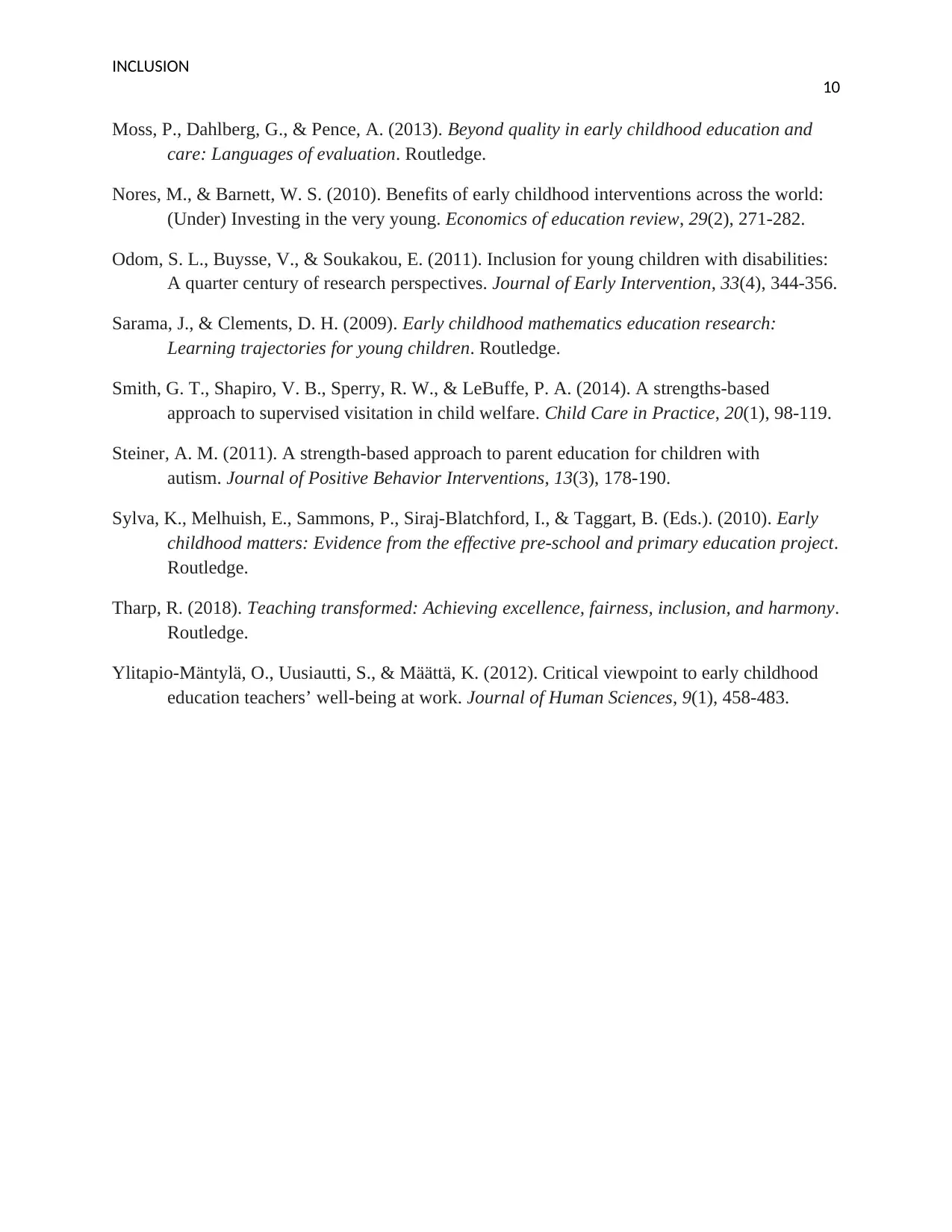
INCLUSION
10
Moss, P., Dahlberg, G., & Pence, A. (2013). Beyond quality in early childhood education and
care: Languages of evaluation. Routledge.
Nores, M., & Barnett, W. S. (2010). Benefits of early childhood interventions across the world:
(Under) Investing in the very young. Economics of education review, 29(2), 271-282.
Odom, S. L., Buysse, V., & Soukakou, E. (2011). Inclusion for young children with disabilities:
A quarter century of research perspectives. Journal of Early Intervention, 33(4), 344-356.
Sarama, J., & Clements, D. H. (2009). Early childhood mathematics education research:
Learning trajectories for young children. Routledge.
Smith, G. T., Shapiro, V. B., Sperry, R. W., & LeBuffe, P. A. (2014). A strengths-based
approach to supervised visitation in child welfare. Child Care in Practice, 20(1), 98-119.
Steiner, A. M. (2011). A strength-based approach to parent education for children with
autism. Journal of Positive Behavior Interventions, 13(3), 178-190.
Sylva, K., Melhuish, E., Sammons, P., Siraj-Blatchford, I., & Taggart, B. (Eds.). (2010). Early
childhood matters: Evidence from the effective pre-school and primary education project.
Routledge.
Tharp, R. (2018). Teaching transformed: Achieving excellence, fairness, inclusion, and harmony.
Routledge.
Ylitapio-Mäntylä, O., Uusiautti, S., & Määttä, K. (2012). Critical viewpoint to early childhood
education teachers’ well-being at work. Journal of Human Sciences, 9(1), 458-483.
10
Moss, P., Dahlberg, G., & Pence, A. (2013). Beyond quality in early childhood education and
care: Languages of evaluation. Routledge.
Nores, M., & Barnett, W. S. (2010). Benefits of early childhood interventions across the world:
(Under) Investing in the very young. Economics of education review, 29(2), 271-282.
Odom, S. L., Buysse, V., & Soukakou, E. (2011). Inclusion for young children with disabilities:
A quarter century of research perspectives. Journal of Early Intervention, 33(4), 344-356.
Sarama, J., & Clements, D. H. (2009). Early childhood mathematics education research:
Learning trajectories for young children. Routledge.
Smith, G. T., Shapiro, V. B., Sperry, R. W., & LeBuffe, P. A. (2014). A strengths-based
approach to supervised visitation in child welfare. Child Care in Practice, 20(1), 98-119.
Steiner, A. M. (2011). A strength-based approach to parent education for children with
autism. Journal of Positive Behavior Interventions, 13(3), 178-190.
Sylva, K., Melhuish, E., Sammons, P., Siraj-Blatchford, I., & Taggart, B. (Eds.). (2010). Early
childhood matters: Evidence from the effective pre-school and primary education project.
Routledge.
Tharp, R. (2018). Teaching transformed: Achieving excellence, fairness, inclusion, and harmony.
Routledge.
Ylitapio-Mäntylä, O., Uusiautti, S., & Määttä, K. (2012). Critical viewpoint to early childhood
education teachers’ well-being at work. Journal of Human Sciences, 9(1), 458-483.
1 out of 11
Related Documents
Your All-in-One AI-Powered Toolkit for Academic Success.
+13062052269
info@desklib.com
Available 24*7 on WhatsApp / Email
![[object Object]](/_next/static/media/star-bottom.7253800d.svg)
Unlock your academic potential
© 2024 | Zucol Services PVT LTD | All rights reserved.





